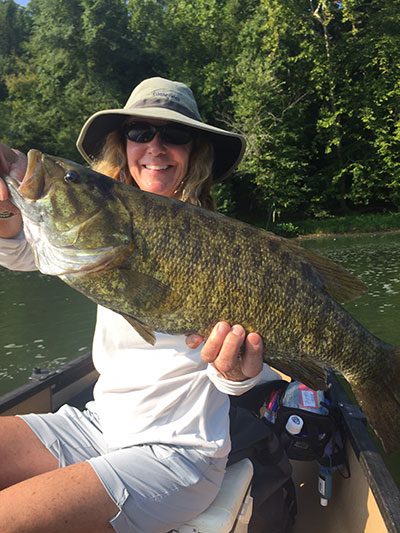There is no disguising that summer is here. Practically everyday most of us living in the midlands experience the bone melting heat as we walk from air conditioning to outdoors. “Why do I live here?” we ask. A river fisherman, though, realizes the brutal heat signals the arrival of prime smallmouth fishing on the Broad River.
As the water temperature rises during summer months, so will the number of smallmouth you catch. That’s because as the water temp increases so does the smallmouth’s metabolism. Some of you are re-reading that last sentence because it’s counter to what most think. I noticed this behavior early on, so I was thrilled to come across the following in a classic “must have” book on smallmouth by noted fly fisherman, Bob Clouser. “When the water reaches 80 degrees and above, the higher temperatures demand more frequent eating in order to supply the energy needed to survive. Some of my most productive periods for catching large bass are during midday in the month of August, when the stream feels like bathwater,” (1) wrote Clouser.
Summer fishing on the Broad is superb. And this month’s Angler column addresses two topics that will help you catch more fish in the river, fish finding, and lure choices.
Okay. You’re in the river so where do you fish? Some fishermen look for calm spots to anchor and avoid rocks. Some drift and sling across the river. Some (a LOT of you) beat the bank fishing structure in slow water. For Smallmouth, during peak season it’s simple. Fish in and around heavy flow. This is why boat safety is so important. You MUST put your boat near heavy flow. You must fish consistently in and around fast running shoals.
If you can’t get out of your watercraft, anchor above the shoal and work the lanes formed between the boulders, then drift down the rapids and anchor below the shoals to fish those lanes. The agility to get out of the boat offers more options. You’re then able to fish more lanes and also able to fish the fast-running water IN the rapids. YES the fish are in there!
If you fish IN, ABOVE, and BELOW the rapids you will probably find fish. Then you can begin putting the pieces of the puzzle together and determine where the best bites are.
Regarding lure tactics, most agree the primary forage for these fish are insects, crawdads, and threadfin shad. And anyone who has fished with me knows I can go out on the river with a bag of Zoom Ultravibe Craws and a few Mepps spinners and I’m set.
Of course, your go-to baits don’t always work, and making adjustments is a big part of fishing. For example, in July I had a co-angler mention he liked fishing jerk baits. The bite was a little slow, so I tied one on, even though that’s a bait I usually reserve for cooler water temps. Much to my surprise, the fish crushed it. Other common adjustments might include dropping your weight size in calmer eddies, going to a bigger spinner in stained water, or going to smaller baits when the bite is really tough. You may even go so far as to drop your line size (diameter) in really clear water.
The final comment on baits is this: Fish your strengths. There is SO much to be said for being confident when you’re out there. So jump on the river NOW folks. Just be sure to check levels before you go and, stay safe!
Mike McSwain is from Charleston, SC but maintains residence in Columbia, SC on the Broad River. He guides for smallmouth bass on the Broad as water levels allow, usually from late Spring through November. Contact Mike at 843-763-3805, or Facebook profile “Michael L. McSwain,” ( Instagram, Facebook Page, and YouTube @broad river smallmouth).
1) Author Clouser, Bob. “Fly Fishing for Smallmouth in Rivers and Streams,” 1st ed.2007
